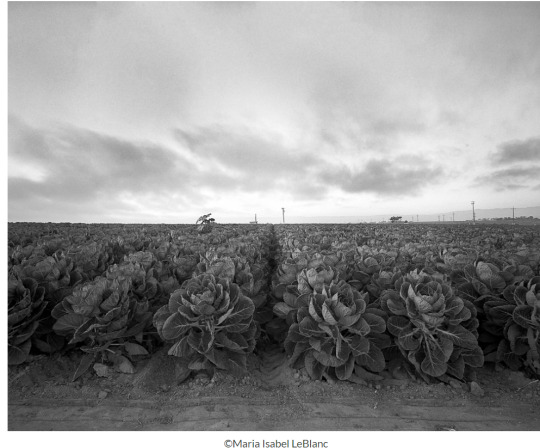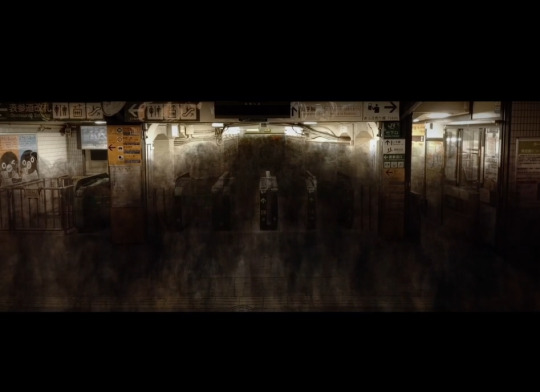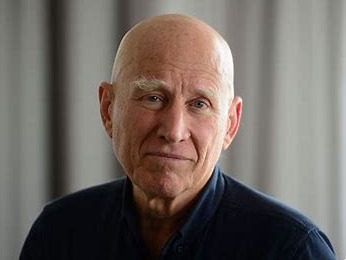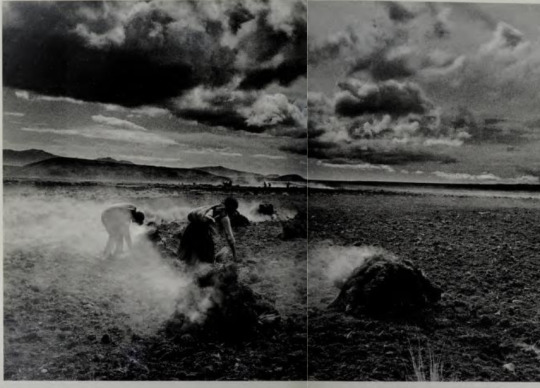Don't wanna be here? Send us removal request.
Text
0 notes
Text
Artist Research #8

Maria-Isabel LeBlanc was born in New Orleans (1969), Louisiana. Maria is the daughter of Cuban and Colombian immigrant parents and the first American generation in her family. Maria graduated with a BA in Romance languages from the University of Georgia, Athens. Maria taught English as a second language for some time before pursuing her photographic studies at Atlanta College of Art.
Her work has been exhibited at places like the "ACP Special Exhibition: picturing justice" along with other photographers. Maria has received recognition of outstanding award from The Denis Roussel Award, 2020.
Maria's work "Brussels on Jensen Road, Moss Landing CA" from her series De La Luz won the People's Choice Award in the Center for Photographic Art's 2020 International Juried Exhibition."
Series: De La Luz by Maria-Isabel LeBlanc: in this series, Maria captures a field of Brussels sprouts with near-perfect symmetry of rows. We can only see a field of Brussels cabbage with an almost clean gray sky and a mountain in the distance that unbalances the symmetry of the rows. Of course, this photograph is in warm silver.
This particular series caught my attention, and I found it somewhat inspiring. Although some might think Maria's work "De La Luz" might be sleepy, it takes me to appreciate the time when I stopped working in the fields of garlic and realized the lost time passing by me. Her work is hard and simultaneously exhausting to see for me. I have to admit her series saddens me but simultaneously takes me back to those fields while scolding myself for my impotence while we see that kind of agriculture take over us.
Maria Isabel LeBlanc: De La Luz - LENSCRATCH
Maria Isabel LeBlanc Photographer - News
0 notes
Text
Artist Reseach #7
Adam Mayger was born in HUngary in 1972. Adam Magyar studied at Budapest University of Technology and Economics, where he earned a degree in Electrical Engineering.Following his studies, he worked as a software developer. Later in his life, he started dedicating his time as a photographer.
Artist: Adam Mayger
Adam Mayger was born in Hungary in 1972. Adam studied photography at the Hungarian University of Fine Arts in Budapest. He graduated from the Hungarian University of Fine Arts in the late 1990s. As of 2024, Adam Magyar is in his early fifties, but he continues to pursue his career as a photographer known for his innovative technique in photography.
Some of Adam's most notable awards include the Lensculture Exposure Awards, the Prix Ars Electronica, and the International Photography Awards. Before focusing on photography, Magyar worked in software development, which influenced some of his later artistic experiments, particularly in merging technology with photography. Adam is also known for capturing the fleeting moments of humanity in urban environments.
Name art piece: Matter
Medium: video
venue of the exhibition: some venue where Adam has presented include: Museum of Modern Art (MoMA), New York City, USA
Victoria and Albert Museum, London, UK,
Venice Biennale, Venice, Italy
Art Basel, Switzerland
For this artist's proposal, it was hard to understand the video provided on the canvas. Therefore, I decided to reference Adam's website. While reviewing some of his works, I found some of them inspiring for my future projects. I think it was a little difficult to understand his relationship with time, but in the end, I had an idea of what he was trying to show us. Recently, I was picturing the aesthetic of my art, and while looking at Adam's work on "Matter," I came up with some ideas about how or what path my art could take. I sought to create dark, aggressive, and even controversial art, and "matter" gives me another point of view on how to do it.
Although Adam explores time in different ways, the aesthetics of the "stuff" seemed to me to show real humanity (that is, humanity in its authentic form). Furthermore, in "Matter," he shows people as a kind of black smoke that disintegrates, which seems remarkably dark, rotten, and inspiring. It's that darkness with an apocalyptic aesthetic that I've tried to create in previous projectors, and that aesthetic combined with that vision of time is depressing (that is, it makes me think of all that wasted time). However, "Stainless" makes me think more about wasted time.

Adam Magyar - Matter (magyaradam.com)
0 notes
Text
0 notes
Text
Artist Research #6
Artists: John Willis
Name: "Recycled realities" (2006)
Date: 2006
Size: 9 x 11 inches
Medium: photography
Published in 2006 by Center for American Places, inc. Santa Fe, New Mexico 87502, USA.
John Willis received his RI master of fine arts degree in photography from the Rhode Island School of Design in 1984. John began his professional career as a professor in the same college. Later on, he continued teaching photography in various schools like Harvard University. John has supported the world of photography significantly, and a clear example of that is his act as co-founder of the In-sight Photography Project (an organization that offers free photography courses). A few of John's standout works include "Recycled Realities: Views From the Reservation," "Views from the Reservation," "Mni Wiconi - Water Is Life: Honoring the Water Protectors at Standing Rock and Everywhere in the Ongoing Struggle for Indigenous Sovereignty," and "Aging in White."
Awards:
Some of his important awards include the John Simon Guggenheim Memorial, Foundation Fellowship in Photography (2011), and 2019 Gold Medal for Best Regional Book from Foreword Indies with work "Mini Wiconi: Water is Life; Honoring the Water Protectors at Standing Rock and Everywhere in the Ongoing Struggle for Indigenous Sovereignty" and Open Society Institute Community Engagement Grant.
Physical description of the work:
The book has a hard cover to ensure durability. It is approximately 9 x 11 inches, and the cover design features related to the theme. The interior consists of high-quality photographs printed on thick Glossy paper. The layout balances images accompanying them with text. Overall, it is a well-crafted, visually appealing book with a messy but intriguing cover and black color.
I was carried away by appearances when choosing this book. When I saw this black book with an intriguing cover, I thought it could be a good selection. After reading a little of the content, it was confusing to understand the work, but it left me with a great reflection on our waste. Since recycling interests me, it got me thinking about the stories on paper, the life they once had, and the life they will have. After all, I liked just seeing the photographs: direct but simultaneously complicated since it was difficult to understand the shapes. Somehow, it was nice watching trash transform into something aesthetic and pleasant.

Teaching in a Variety of Settings | John Willis | Photography (jwillis.net)
Publications | John Willis | Photography (jwillis.net)
GFT Publishing - John Willis (gftbooks.com)
John Willis — Gallery Kayafas
0 notes
Text
Moisés Samán is a Spanish Peruvian journalist born in Lima, Peru, to a Spanish mother and Peruvian father.
Moisés began as a photographer working as a photojournalist in the Middle East in 2011. He is best known for his war photographs. Some wars that Moisés has photographed include the Iraq war and the conflicts in Afghanistan, Libya, and Syria.
On February 29, 2024, Moses documented aid by the Jordanian Air Force to Palestine. In this mission, the Jordanian Air Force dropped aid boxes for Palestinians. These boxes contained food and water, among other types of aid. For his part, Moises photographed the work of these people, from lifting the boxes to dropping them in the north of Gaza. In these photographs, we can see the personnel in charge of the boxes before being loaded onto the airplane and the personnel loading them. Also, he shows some photos of the zone where they will drop the aid and finally, how these boxes are being dropped.
We can see a line of aid boxes behind the aid team's airplane ready to load the boxes. Afterwards, we can see the cardboard boxes with aid backpacks on the top before packing them to be dropped off. Then, we see the personnel loading this box on the airplane with a machine. Finally, we get some photos of Gaza; where we can see a huge desert town, mostly surrounded by houses near the sea with very few green areas. We can also see a photo from the bottom of the plane; as the box slides to fall from 10,000 meters over Gaza.

I liked this series of photos because it shows a part of a story in a fluid way. Besides, the photographer interests me since he shows very controversial topics such as war. This series gives me an idea of how a series of photos should flow to tell a story.
Aid Airdrops Over Gaza, Documented by Moises Saman | Magnum Photos
Aboard Jordan's aid airdrop over Gaza, a last resort for relief to Palestinians there : NPR
0 notes
Text
Looking through some artists I found AN-MY le, whose work seems to me somewhat controversial. An-My le was born in Saigon, Vietnam 1960 but works as a photography professor at Bard College in Brooklyn, New York
An-My graduated from Stanford University as a biologist and received her MFA degree (Master of Fine Arts) in photography from Yale University. An-My began her career as a photographer around the 1990s after graduating as a biologist.
An-My's early work includes; "Viet Nam '' (1994): In this series, An captures the impact of war on the environment and culture of VietNam. "Small Wars" (1999-2002): This series contains some provoking images in which she captures battles during the Vietnam War reenactment, the Viet Cong camps, and soldiers resting, among other pictures that give us another perspective of the historical context of the conflict.
An-My le has exhibited her work in various museums and galleries, which include The Museum of Modern Art, New York, Marian Goodman Gallery, New York, NY, and MoMA PS1, New York, NY.

Among her various prominent works, I found "Small Wars" from 1999, which I thought was very interesting to see the recreation of the Vietnam War. These pictures recreate that historical event very well, but the one that impacted me captured soldiers sleeping. In this picture, An captured a camp tent between the forest and some soldiers sleeping in front of it.
Personally, I like this series because as a whole it does capture the sense of war.

Awards:
Some of the most important awards and honors include "The Louis Comfort Tiffany Foundation Awards' ' (2009), which celebrated An-My as an emerging artist, and "Anonymous Was A Woman' ' (2006), which recognizes female artists and their contribution to the art world.
An-My's best-known and most important works include; "Small Wars" (1999-2002), "Viet Nam" (1994-1998), and "29 Palms" (2003-2004).
An-My Lê | International Center of Photography (icp.org)
Small Wars — An-My Lê (anmyle.com)
0 notes
Text
Artist research #3
Artist Background;
Sebastião Salgado was born in Aimorés, Brazil February 8, 1944. Initially, Salgado started as a photographer around the early 1970's thanks to his previous job as an economist. His work required him to travel a lot, and so these trips started his eagerness to capture his experiences during his travels.
His first photographic journey started as a freelancer photojournalist working for agencies such as Sygma, Gamma, and Magnum. He has published many of his documentaries including "The Other Americas'' (1986), Sahel: L’homme en détresse (1986), and Workers (1993).
His work focuses on capturing the everyday life of people from distinct cultures around the world. Some of his work depicts social justice, human rights, and environmental issues. Some of his great work has been exhibited in many galleries, museums, and institutions, and they can be seen in Sundaram Tagore Gallery (New York), Barbican Art Gallery (London), and the International Center of Photography (New York). Important awards of Salgado include the Arles International Festival prize in which his work "Genesis" won for the best photography book. Some others include the Erna and Victor Hasselblad Award for visual storytelling, the W. Eugene Smith Memorial Fund Grant (1982), or the W. Eugene Smith Memorial Fund Grant (1982) for being committed to storytelling and social changes. Also, among his important works, we can find some of the most known such as "Migrations" or "Genesis."

Picture taken from his work “The Other Americas”, black and white film photography, Bolivia 1977.
This picture was taken in Bolivia and it captures people gathering or burning something in the open landscape but In my opinion, they are burning grass to prepare the land for tilling.

The work of Sagaldo is very depressing to me, it shows the hard part of everyday life of people. This picture in particular caught my attention because it seems more cruel to me. All his pictures in “The Other Americas' ' depict cruelty but I had to choose one and so I decided this one captures a lot of pain. I think it is a good example of how to take an amazing picture.
Sebastião Salgado | International Center of Photography (icp.org)
0 notes
Text
0 notes
Text
Project Proposal
For this project I intend to photograph rural workers in their daily agricultural activities. As the San Joaquin Valley is diverse in crop types, I will focus on capturing the tangerine or orange harvest. I plan to capture their environment during work and give you a sense of being there. As we know, the cultivation process requires many stages, such as planting, irrigation, pest control, and harvesting. In that sense, this project intends to capture farmworkers as a vital element in maintaining the metropolis and the lifestyle of the people in the metropolis.
Through my photographs, I want to show the effort and pain it takes for field workers to produce food. Part of the reason for capturing field workers comes from my cultural background. Initially, we practiced subsistence agriculture but shifted to work in industrialized agriculture due to economic and immigration issues. Since I come from a culture where agriculture is of great importance and we identify ourselves as farmers more than anything else, it has had a negative impact seeing how we switch to industrial agriculture. We are witnessing the disappearance of our identity and the lifestyle achieved with subsistence farming.
The strategic approach I attempt to use mixes capturing the subjects as they happen and capturing the subject directly. As for the equipment needed, I only plan to use the camera and air blower. In terms of lighting, as most of the photos will be outside, it would be natural light.
The experience I would like the viewer to take with them is a different perspective of where their food comes from. The audience will take away another perspective of things, put themselves in the shoes of others, and perhaps value more everything they have. Maybe make them be part of a movement to seek justice for those at the bottom.
0 notes
Text
8 elements and 8 principles of art and design, and their definitions
color : Defines the pigments used in a painting or picture.
Form : Form describes a 3-dimensional object in space.
Line : It is a moving point through space.
Shape: 2-Dimentional sense of space created by a line that encloses an area.
Space : Area ocupied by an object in a piece of art or painting. the area around, between or within an object in an art piece.
Texture : Surface of artwork, actual or implied on artwork.
Value : Range from light to dark from one color like white to black.
Point: Area where two or more cordinates vanish or meet.
Balance: Point: Area where two or more coordinates vanish or meet.
Contrast: Opposites created with color or other elements within an artwork.
Emphasis: Point or object within an artwork that attracts most attention.
movement: Movement: Used of different elements or art and design to represent motion/ action in an artwork.
Pattern: Repetition of different elements in an artwork.
Rhythm: Unlike Pattern, the used of repeated elements to guide the eye trough the artwork.
Unity: Forms or objects or other elements that is abundant in an artwork which together create a sense of a whole.
Variety: Different or distinct objects or elements in an artwork.
0 notes
Text
Scavenger hunt
https://docs.google.com/presentation/d/1vzQBTVQRgcuo4a5bmHoxwvKw-rxCqWSp0CMNe6f5v8E/edit?usp=sharing
0 notes
Text
Artist Research
I decided to write about Eniac Martinez Ulloa (1959-2019) for my first research about a photographer. Born in Mexico City in 1959, he began his career as a photographer around 1980, and his first work was in 1994 called Mixtec North/South. In the photographs of his project, Eniac shows scenes of the daily life of the Mixtecs, as well as their journey to the border or their work in the United States. Among these photographs, we can find one called "La Frontera," Tijuana (1989), which translates as The Boarder: in this picture, he captures a line of crosses placed for the deceased who died at the border. In the background, it depicts police officers who seem to be arresting immigrants over a hill. The picture is in black and white, as in most of his works, but from my perspective, the black and white appeals to more negative feelings about the harsh reality at the border.
When I was looking for a photographer for my research, I decided to look for someone more local to me, and I found Eniac, who surprised me as his first work as a photographer was about my people's journey to this country. The picture named "La Frontera" caught my attention the most as it made me think of the cruel reality my people and others go through on the border. Personally, the black and white pictures got my attention the most as I found the line of crosses really raw, cold, and sad. What I liked the most about this photo is the color accompanied by the crosses in a place so abandoned that it embraces only death. The best part is that it gives me so many ideas of how I can present a story through pictures.
v1.zonezero.com/exposiciones/fotografos/eniac/3e.html
Eniac Martínez: el camino hecho historia | Oscar en Fotos

0 notes
Text
My Weekend

Looking for something photograph.
This weekend was quite boring, begore going home I went around campus and tried to find something to take a picture of, but it was getting dark, so I took a picture of the campus.

Practice 1. It's getting dark. Afterward, I could not find anything else, and I had a few minutes to walk around campus, so I decided to practice a little more with my camera.

Practice 2.

Practice 3. Leaving.

Checking on the herbs in my backyard. I was in my room almost all day working on my art project, but I made an exception this weekend, so I went outside to take a break.

Continue working on my project. I finished one part.

Done. I Finished the second part of my project; I took all day making it so now it's time to sleep.

Time to sew. Finally, for the last two days I work on a sewing a sweater. I didn't finish, so I decided to give myself a break and go outside on my backyard again.


Break. Breathe.
The picture of the tree is from Thursday, but I put it there because three days after I noticed that the tree was blooming.
The End.
0 notes
Text
My name is Lisandro, I hope to learn how to take good photos as I would like to use photography to have some artistic projects related to photography. I enjoy playing my guitar, drawing, and making sculptures.

0 notes